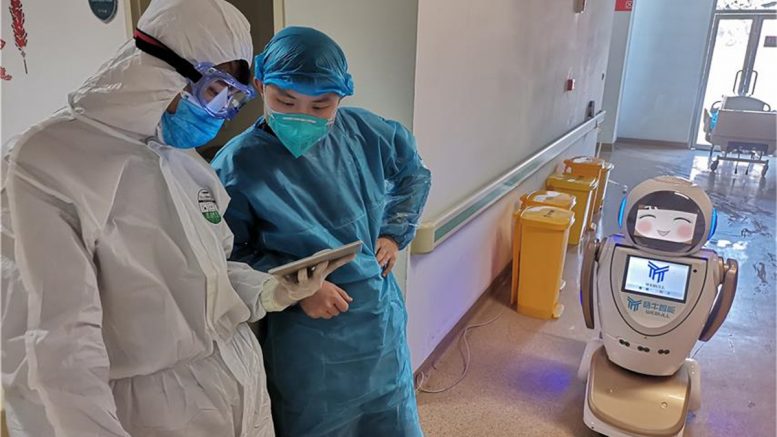Battling a pandemic as severe as COVID-19, demands immediate measures, tools that accelerate the delivery of treatment in a variety of settings that can easily diagnose cases of coronavirus. Digital tools such as telehealth, cloud computing, robots and AI-based chatbots are playing a key role in limiting the outbreak of COVID-19. As China initiated its response to the virus, it leaned on its technological sector, artificial intelligence (AI), data science to track and fight the pandemic. Listed below are some of the ways in which technology is tracking and fighting the pandemic.
1. Telemedicine offering online health consultation
Telemedicine is evolving as a sustainable solution for prevention and treatment of COVID-19. It is enabling patients to stay at home and communicate with physicians virtually and reduce the spread of viruses. Health services are being urged to leverage telemedicine technologies and self-assessment tools to provide remote care for patients with non-urgent matters.
For example, Tyto Care, a telemedicine technology company is expanding their use of telehealth solutions to remotely examine, diagnose and treat patients at home while providing them with professionals, clinical data as well as minimize any sort of physical contact to avoid the spread of COVID-19.
2. Smartphone apps to curb the community spread
Smartphones are playing an important role in monitoring a patient’s health. Apps have been developed to monitor people infected with COVID-19 and aimed to track registered individuals using their phone’s GPS.
It lets people record their movements and correlate them to those of known patients with coronavirus, using filtered data given via national departments of public health. Additionally, users will also be asked if they are infected, providing a way to identify potential transmission.
Further, Apple has also launched an app, Apple COVID-19 which helps in screening users. It also offers an online screening tool and some guidance on when to seek testing of COVID-19. You will also receive answers to your frequently asked questions related to COVID-19 on this app.
3. Robots and drones for supply chain management
Robots and drones prove beneficial when it comes to providing valuable goods to people who shop and buy online and are quarantined at home. They are immune to infection and are helping in delivering food and supplies. Robots can be used for disinfection, distribution of drugs and food, and assessment of vital signs.
Tech companies such as JD.com and others have stepped up to the challenge to get more robots out in force to deliver medical supplies within healthcare environments. Drones are also being used to spray disinfectants and carry out contactless disinfection of areas on a large scale.
Through thermal sensing, drones are also assisting crowd control officials and recognizing people with elevated body temperatures that might indicate that they were infected with the virus.
4. AI to identify, track and diagnose outbreaks
Rapid innovation in healthtech including new applications of artificial intelligence(AI) and machine learning(ML) for screening people and assessing infection risks have made AI a crucial contributor to identify, track and diagnose outbreaks.
Further, technology such as Natural Language Processing(NLP), Machine Learning(ML) and location monitoring can diagnose where outbreaks are likely to occur. For example, tracking infectious disease risks by using AI is exactly the service Canadian startup BlueDot provides.
AI can further integrate population, travel, and disease data to predict where and how quickly disease might spread. Governments and healthcare organizations are using this information faster to respond to the disease. It also helps in making better treatment decisions based on medical imaging.
AI can help in discovering new viruses by analyzing data from any similar viral diseases and then using that data to track which types of vaccines and medicines are most likely to be effective. For example, data from coronavirus patients’ chest X-rays can act as guidance for AI models, so doctors can render diagnoses more quickly.
5. Supercomputers working on a coronavirus vaccine
Supercomputers are used in activities such as medication discovery, materials production to solve computational problems. Supercomputers of several major tech companies such as DiDi, and Huawei are being used by researchers to fast-track the development of a cure or vaccine for the virus.
These are especially well equipped to analyze and process large volumes of data using algorithms for artificial intelligence. The speed of these systems can run calculations and model solutions is much faster than standard computer processing.
For instance, supercomputer of C3.ai Digital Transformation Institute (DTI) is planning on investing millions into grants to advance AI techniques for containing the spread of COVID-19.
Conclusion
Lastly, healthcare centres across the globe are switching to the above mentioned emerging technologies to help lighten their workload, whether by assisting speed up diagnostics or by enabling doctors to track patients who have been quarantined remotely.
About the author
Rahul Varshneya is the co-founder and president of Arkenea, a digital health consulting firm. Rahul has been featured as a technology thought leader across Bloomberg TV, Forbes, HuffPost, Inc, among others.





